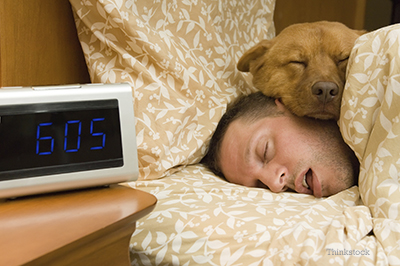
It’s time for our twice-yearly clock adjustment to save energy and eliminate excuses to wake up earlier. Everyone in U.S., with the exception of Arizona and Hawaii, sets clocks forward one hour at 2 a.m. on the second Sunday of each March. This inevitably causes millions of Americans to miss worship the following morning and millions more to be sleepy for the next couple of weeks. While we pour an extra cup of coffee on Monday to shake off the lost sleep, what effect does daylight savings time have on our dogs?
History of daylight savings time
According to timeanddate.com, Benjamin Franklin is part of the reason we change our clocks. He observed people burned candles to work into the night and sleep during the morning sunshine, wasting valuable oil, wax and free light. Franklin suggested, jokingly, in an essay, “An Economical Project for Diminishing the Cost of Light” that Parisians could adjust clocks according to the seasons to save resources and maximize productivity. In 1916 the Germans became the first country to officially implement the idea. The U.S. followed during World War I in 1918, resulting in almost a century of grumpy Americans complaining each March about a “lost hour.” This 60-minute modification really throws our body’s natural rhythm out of sync resulting in insomnia, moodiness, lost focus and productivity. Our dogs also feel the effects of the time change, although not in the same ways we do.
How are dogs affected by daylight savings time?
Dogs are creatures of light. That is, animals are closely tuned to the cycles of light and dark in terms of their physiology and behavior. Dogs tend to wake when the sun rises and sleep after sunset. Many dogs have precise patterns; they do the same things at the same time every day like clockwork, but they can’t read clocks. Because dogs can’t read time, arbitrary movements of the hour hand should have less affect on their daily routines. Or does it?
What really disrupts our dog’s lifestyle during daylight savings time changes are the sudden differences in our daily routines. Your dogs will probably be awakened an hour earlier or later to go potty. Their meals will be served at a different time; walks are rescheduled and it feels different when human family members come and go. Mornings get brighter and come earlier and evening walks warmer and later. For most dogs, these changes are abrupt, unexpected, and challenging. They may ponder, “Why am I eating now? Why do I have to get up so early?” We need to ask how we can help our dogs adjust to time changes.
Helping our dogs adjust to daylight savings time
For most dogs and people, the time switch is “no big deal.” Sure, the first week may be a little unsettling but nothing an extra shot of caffeine or an additional walk can’t correct. The key is to have a routine and stick to it. Even though you may not be tired because the clock says 9 p.m. and your body feels like it’s 8 p.m., it’s important to go to bed at your normal time. Let your dog outside and put him to sleep at the regular time. He may stare at you quizzically and tell you that he's not ready. Don’t listen to him. The sooner you lock into the new schedule, the sooner you’ll be acclimatized and rested. And who couldn’t use a little more sleep?
If you have a dog that has difficulty sleeping or is extremely sensitive to time changes, ask your veterinarian about using a nutritional supplement such as melatonin or relaxing scents. Longer walks or more playtime, can help improve sleep quality and patterns.
Meals should be fed at roughly the same time each day, year round. Avoid high carbohydrate or sugary foods, especially before bedtime. I’m a big advocate of daily routines, especially morning rituals. Wake, walk, feed and walk again before leaving. Dogs are true “creatures of habit” and relish routines.
Because our dogs are closely connected to the environment, the prolonged days of spring and summer naturally encourage them to become more active. Many dogs will behave friskier after the spring solstice. I call this the “Springtime Rally” in many of my older patients, as they seem to gain renewed vigor as the weather warms.
The take home message is to be aware that your response to daylight savings time directly impacts your dog. Grumble if you choose, but take solace knowing your dog welcomes the time change. He welcomes longer days because that means more playtime; longer, warm naps and extra time spent together. And that’s always good.
If you have any questions or concerns, you should always visit or call your veterinarian -- they are your best resource to ensure the health and well-being of your pets.
